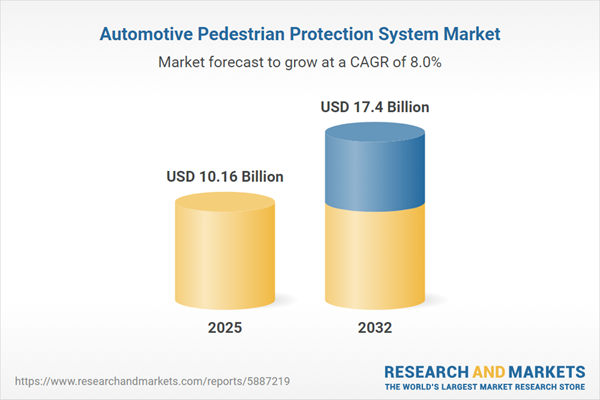Speak directly to the analyst to clarify any post sales queries you may have.
As regulatory expectations tighten and new technologies emerge, automotive leaders face complex challenges in implementing pedestrian protection systems. Proactively navigating compliance and leveraging innovation in safety features are now essential for maintaining global competitiveness and risk resilience.
Market Snapshot: Automotive Pedestrian Protection System Market Size and Growth
The global automotive pedestrian protection system market reached USD 9.39 billion in 2024 and is projected to expand to USD 10.16 billion by 2025, with forecasts to USD 17.40 billion by 2032. This growth equates to a compound annual growth rate (CAGR) of 8.01%. Market momentum is driven by stricter worldwide safety regulations, ongoing innovation in detection and avoidance capabilities, and the increasing priority of compliance within automotive manufacturing and supply networks. Companies are evolving operational frameworks and accelerating the adoption of advanced safety solutions to efficiently manage regulatory obligations and integrate pedestrian protection across wide-ranging vehicle fleets.
Scope & Segmentation
- Vehicle Types: Solutions are tailored for passenger cars, light commercial vehicles, and heavy commercial vehicles. Each segment experiences unique pressures based on operational settings and specific safety requirements, influencing both design and compliance priorities.
- Pedestrian Detection Technologies: Monocular and stereo cameras, infrared sensors, LiDAR, and both conventional and solid-state radar are applied. Varying technology choices enable reliable performance in diverse scenarios, from urban intersections to rural roads.
- System Types: The market integrates active features such as autonomous emergency braking and pre-crash alerting with passive elements like deployable hoods and energy-absorbing bumpers. This holistic approach addresses a broad spectrum of regulatory and operational targets.
- ADAS Tiers: Offerings span from basic driver-assistance systems up to advanced autonomous platforms, allowing organizations to align safety strategies with regulatory timelines and automation roadmaps.
- Distribution Channels: Products are available for original equipment integration in new vehicles and as retrofit options for existing fleets. This supports both immediate compliance efforts and strategic upgrades over time.
- Regional Markets: System adoption is shaped by distinct regional regulations and customer expectations. North America, Europe, Asia-Pacific, and the Middle East and Africa all represent markets with differentiated entry strategies, timelines, and operational dynamics.
- Leading Companies: Autoliv, Robert Bosch GmbH, Continental, ZF Friedrichshafen, Denso, Valeo, Aptiv, Hyundai Mobis, Gentex, and Hella influence sector direction through collaborations, regulatory engagement, and consistent technology development.
Key Takeaways: Strategic Insights for Senior Decision-Makers
- Advanced pedestrian protection now features prominently in fleet procurement agendas, prompting more active involvement in technology selection and rollout planning at the executive level.
- Automakers and suppliers are strengthening supply chains by prioritizing agile management and regional sourcing, ensuring operational continuity amid shifting compliance and logistics demands.
- Collaboration among original equipment manufacturers, tier-one suppliers, and technology startups is accelerating the introduction of next-generation safety features for both new builds and fleet retrofitting.
- Retrofitting remains vital for regulatory alignment. Extending this approach helps companies keep existing vehicle assets compliant and prolongs the effective life of fleets as safety standards advance.
- Multi-sensor systems improve detection reliability in variable environments, supporting risk mitigation efforts, particularly in regions with mixed infrastructure and challenging traffic patterns.
- Flexible, customizable protection solutions allow organizations to fine-tune safety investments, balancing regulatory risk, operational needs, and geographic diversity.
Tariff Impact: Navigating United States 2025 Automotive Tariffs
New U.S. automotive tariffs anticipated for 2025 are prompting manufacturers to review and adapt procurement and production strategies. Companies are increasingly adopting near-shoring, establishing regional production facilities, and implementing modular manufacturing to ensure supply reliability. A trend toward greater vertical integration is also emerging, helping preserve cost efficiency and responsiveness as trade and regulatory environments shift.
Methodology & Data Sources
This analysis reflects direct feedback from global vehicle manufacturers and tier-one suppliers. It combines expert validation with ongoing review of industry documentation and regulatory updates to ensure practical, current insights for senior decision-makers.
Why This Report Matters: Value for Senior Decision-Makers
- Use current market insight to guide proactive strategy and select the right technologies for fleet and procurement planning.
- Benchmark operational models against best practice to support effective pedestrian protection upgrades and seamless integration across vehicle platforms.
- Boost business resilience and readiness for regulatory change by targeting emerging safety solutions and strengthening risk controls.
Conclusion
Navigating evolving regulations and operational requirements requires organizations to prioritize flexibility, compliance, and continuous innovation in pedestrian protection systems. Adapting to diverse local demands helps sustain performance and drive ongoing strategic progress.
Additional Product Information:
- Purchase of this report includes 1 year online access with quarterly updates.
- This report can be updated on request. Please contact our Customer Experience team using the Ask a Question widget on our website.
Table of Contents
3. Executive Summary
4. Market Overview
7. Cumulative Impact of Artificial Intelligence 2025
Companies Mentioned
The companies profiled in this Automotive Pedestrian Protection System market report include:- Autoliv, Inc.
- Robert Bosch GmbH
- Continental Aktiengesellschaft
- ZF Friedrichshafen AG
- Denso Corporation
- Valeo SA
- Aptiv PLC
- Hyundai Mobis Co., Ltd.
- Gentex Corporation
- Hella GmbH & Co. KGaA
Table Information
| Report Attribute | Details |
|---|---|
| No. of Pages | 184 |
| Published | November 2025 |
| Forecast Period | 2025 - 2032 |
| Estimated Market Value ( USD | $ 10.16 Billion |
| Forecasted Market Value ( USD | $ 17.4 Billion |
| Compound Annual Growth Rate | 8.0% |
| Regions Covered | Global |
| No. of Companies Mentioned | 11 |









